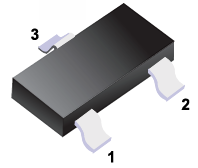Fast Switching Speed
Date:2025-06-23 Categories:Product knowledge Hits:225 From:Guangdong Youfeng Microelectronics Co., Ltd
Key Characteristics
Fast Switching Speed
One of the most significant advantages of
digital transistors is their ability to switch between the on and off states at extremely high speeds. This rapid switching is crucial for digital circuits, especially in high-frequency applications like microprocessors, memory chips, and communication systems. For example, in modern computer processors, digital transistors can switch billions of times per second, enabling the execution of complex instructions and data processing at incredible speeds.
Low Power Consumption
digital transistors are designed to consume very little power, especially when in the off state. In this state, the leakage current is minimal, which helps in reducing the overall power consumption of digital devices. This characteristic is vital for battery-powered devices such as smartphones, tablets, and wearable electronics, where extending battery life is a top priority.
High Noise Immunity
digital transistors are less susceptible to noise compared to their analog counterparts. Since digital signals represent only two distinct states (0 and 1), a certain amount of noise can be tolerated without affecting the integrity of the signal. As long as the noise does not cause the signal level to cross the defined threshold levels for 0 and 1, the
digital transistors can accurately reproduce the correct output state, ensuring reliable operation of digital circuits.
Applications
Logic Gates
Logic gates are the fundamental building blocks of digital circuits, and
digital transistors are essential for constructing them. For example, in a simple NAND gate circuit, multiple
digital transistors are interconnected in a specific configuration. Depending on the input voltages (binary 0 or 1), the transistors either conduct (turn on) or do not conduct (turn off), producing the appropriate output voltage according to the NAND logic function. This principle applies to all types of logic gates, including AND, OR, NOT, NOR, and XOR, enabling the creation of complex digital logic systems.

Previous:
Classification, Structure, and Principle of MOSFET
Next:
Microcontrollers and Microprocessors
